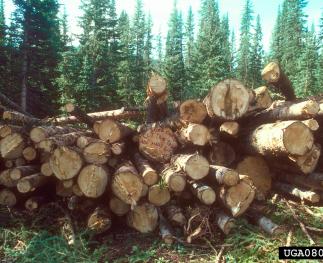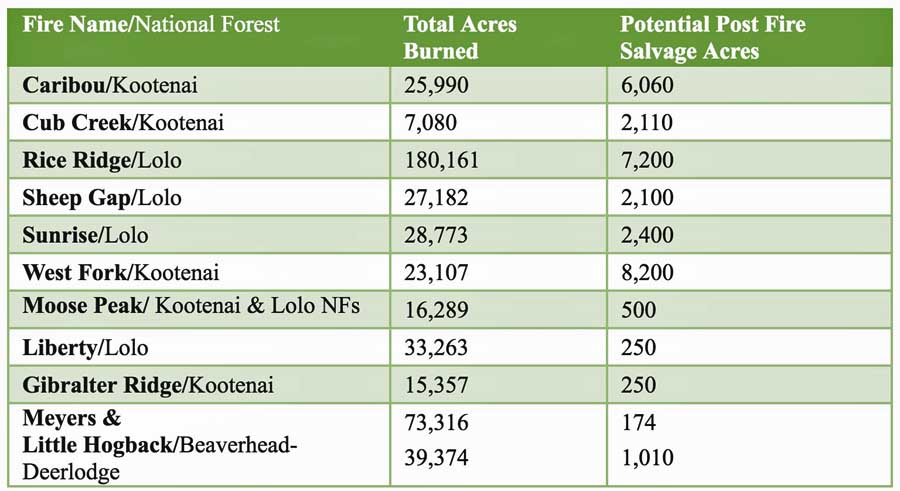
The U.S. Forest Service expects to award salvage logging contracts totaling 30,254 acres in 11 locations scattered over three National Forests in Western Montana. The burned areas affected are on the Kootenai, Lolo, and Beaverhead-Deerlodge National Forests. The Northern Region will be requesting approval for Emergency Situation Determinations for some of the areas which would streamline the environmental analysis process.
Below is information from the USFS Northern Region:
This past summer, the U.S. Forest Service’s Northern Region experienced one of the hottest and driest fire seasons on record, with 36 fires that burned ~710,000 acres on National Forests in Montana and Northern Idaho, heavily impacting local communities and landscapes. As a result, recognizing the scope of the fires this year, Regional Forester Leanne Marten saw the need for an expedited approach focused on safety and formed a Regional Post-Fire Response Incident Management Team (IMT). This team oversees Burned Area Emergency Response (BAER) assessments and implementation, planning for post-fire salvage, and reforestation assessments.
“We’ve had many years where we’ve had fire on the landscape and we’ve learned there is a lot of work left to do on the ground for the resources and for the communities when the flames go out and the smoke clears”, said Marten. “How we do that and work together across landscapes is imperative to our success, and based on feedback we’ve had from our employees and community’s from previous fires… we’ve learned a Regional approach is the most effective.”
Emergency response actions began on those areas posing the greatest risks to human life and property immediately; over 505,320 acres have been assessed. Specialists came from across the country to expedite this work, and the Forest Service has contracted with local businesses extensively to implement work on the ground. The work focuses on replacing safety related structures, removing safety hazards and installing hazard warning signs and temporary barriers as needed. Other work includes erosion and water run-off control structures on roads and trails, mitigating the loss of habitat for threatened and endangered species, helping to prevent the spread of noxious weeds and protection of sensitive cultural resources.
On NFS lands burned this year in Montana, salvage locations are proposed based upon physical conditions on the ground and existing management direction. Computerized evaluations are being used to rapidly zero in on the areas with suitable timber volume and road access. Regional guidance is being developed to minimize potential environmental impacts and fulfill Endangered Species Act requirements.
The Region has been talking with members of various conservation organizations, cooperators, stakeholders and volunteer groups about efforts to salvage timber value in burned areas. There have also been numerous conversations with representatives from the timber industry. We are highly committed to engaging the public throughout the process.
Eleven fires (see table) are slated for salvage projects and of those, three are proposing to salvage 250 acres or less. Environmental analysis will determine the final acreage available for salvage for the remaining eight fires.
Additionally, the Region will be requesting approval for Emergency Situation Determinations (ESD) for some of the areas which would shorten the environmental analysis timeline and allow work on the ground to begin sooner.
The Northern Region is strategically focusing its efforts to maximize safety, minimize environmental impacts, and use the available industry capacity to accomplish this work to benefit our communities and resources. Assessments are being conducted for reforestation needs at the same time for the health and productivity of these areas. As exclaimed by Regional Forester Marten, “We are excited to have our local decision-makers on the Lolo, Kootenai, Helena-Lewis and Clark, and the Beaverhead National Forests working with the Post Fire Response IMT to get this work done safely and quickly”.
Detailed information about the Forest Service post-fire work can be found online.

What does the U.S. Forest Service’s current plan for up to 370 million board feet of post-fire logging on America’s National Forests in Montana look like?
It would take 74,000 log trucks full of trees lined up for 630 miles to haul out 370 MMBF of trees. That means someone could drive I-90 from Lookout Pass, Idaho to Miles City, Montana and log trucks full of trees would be lined up the entire way.
That is a lot of wood. Thank goodness the USFS is leaving 99.97% of the acres that burned this year untouched and preserved as habitat for cavity nesting species.